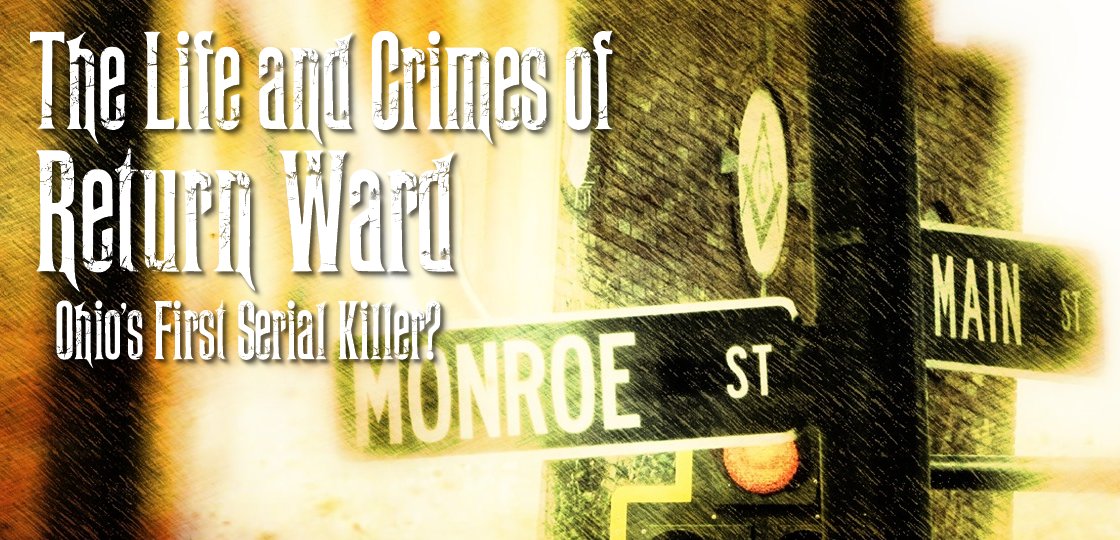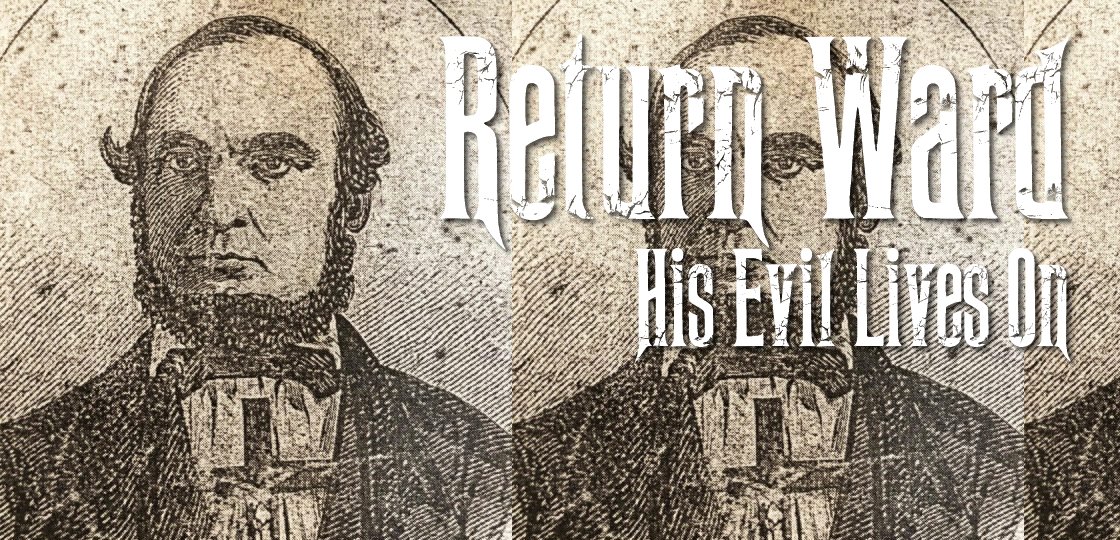Return Jonathan Meigs Ward was born in Milan, Ohio in 1815. His father, Jared, a successful farmer and one of the area’s first settlers, was a well-known and highly regarded man in the community.
Tragedy struck early in Return’s life; his mother passed away when he was two-years-old. Despite his tender age, the loss likely left him with a sense of abandonment, coloring his views and associations with women throughout his life.
Jared, favoring a more formal education for his daughters, sent them to the local schoolhouse. When it came to his sons, he sought to instill a trade. While Return’s brothers learned the family business, Ward never followed in those footsteps. Perhaps for reasons of disinterest, lack of skill, or an insufficient aptitude, Return never embraced farming.
At the age of nine or ten, Return began working as a cabin boy and cook on the Lake Erie schooner, Dread. This experience, although some speculate it was abandonment, might have been an apprenticeship that his father was able to set up through his community connections. It was during this time that Ward suffered a leg injury, leading to a hobbling gait that would persist throughout his life. The cause of the leg injury is still unknown, but some speculate it may have been caused during a shipwreck.
After the Dread was sold, Ward returned home to the family farm. He would be around 11-years-old at this time. Sensing that the nautical life wasn’t suitable for his son, Jared then arranged for Return to go to Columbus, Ohio where he apprenticed as a blacksmith under his brother-in-law’s supervision. This kind of work also did not seem to capture his interest or aptitude. Finally, Return switched to tailoring, and this would be the profession that he stuck with for the rest of his life.
Throughout his early life, he moved frequently, working for various individuals and never settling for more than a few years in one place. Based on what we know about his life, we find ourselves speculating whether or not he was seeking better opportunities or simply fleeing from his troubles? Known for his gruff demeanor, foul language, and violent temper, Ward often found himself in legal trouble. So this could be one of the main reasons he never laid down roots in one spot for too long. On the other hand, Ohio, at this point in history, was still very much an untamed frontier. He simply could have been following the money, moving from one promising railroad stop to the next.
At 26, working in Milan as a tailor, Ward assaulted a fellow journeyman, breaking the man’s shoulder. Legal issues stemming from his impulsive temper would persist, including an incident in Mansfield where he threw a rock at a co-worker, which wound up with him serving a few weeks in jail. In many of these cases, Ward’s father would step in to pay any fines, bail him out, or offer money to victims to drop the charges.
In 1843, Ward married Sarah Lamson against her father’s objections. They moved to Cass Township in Richland County, Ohio, where Ward faced even more legal troubles, including accusations of burning a rival’s house. Acquitted of these charges, Return and Sarah left town, living trouble-free in Huron County for a few years.
In 1847, Ward assumed proprietorship of the Eagle House in Planktown, where Noah Hall, a local resident running a general store, was a frequent visitor. Hall, in the midst of preparing for an eastern trip to procure the upcoming Spring inventory for his store, often dined at the Eagle House. During casual conversations, Ward got wind of Hall’s impending journey, aware that he would be carrying a substantial sum of money for his purchases. Driven either by greed or desperation, Ward decided to capitalize on this opportunity. Under the veil of darkness on the night of March 17, 1850, he stealthily entered Hall’s store and subdued him with a brutal assault. Cementing the tragic fate of the merchant, Ward resorted to a violent strangulation, leaving behind a staged scene to make it appear as a failed robbery. That fateful night, Ward made off with a significant haul, ranging from $800 to $1500—an impressive sum in 1850, equivalent to $31,000 to $58,000 in today’s currency.
Upon discovering Hall’s tragic demise, Ward played a pivotal role in steering suspicion toward two local step-brothers notorious for their disruptive behavior. Remarkably, he even took on the role of a witness in their prosecution. However, as the trial unfolded, Ward’s testimony revealed certain inconsistencies that led to the acquittal of one brother and the dismissal of charges against the other. With the spotlight now turning towards Ward as a potential culprit, suspicions intensified, yet prosecutors struggled to unearth any evidence substantiating this claim.
The tumultuous relationship between Ward and Sarah took a dark turn, culminating in her institutionalization, a move that some speculate was aimed at suppressing any potential revelations about Hall’s murder. According to Ward, Sarah underwent a severe mental breakdown, grappling with the unraveling of her sanity. She was sent to an institution in Columbus, Ohio, before eventually relocating to reside with her parents.
In 1852, a traveling tin peddler known as Mr. Lovejoy arrived at the Eagle House, seeking a meal and a place to rest for the night. As Ward lay in bed, a sinister idea crossed his mind—how effortlessly he could eliminate the unsuspecting peddler and seize whatever money and valuables he possessed. The notion appealed to Ward, relishing the challenge and thrill it promised. Under the cloak of darkness, he stealthily entered Lovejoy’s room and dealt a fatal blow with a single swing of an ax while the peddler slept. Wrapping Lovejoy’s lifeless body in blankets, Ward stuffed it into a dry goods box, a task that required him to sever the legs for a proper fit and closure. At dawn, Ward loaded the box onto a wagon and embarked on a journey of about 60 miles north, heading toward his father’s farm. Under the shroud of night, he discarded the macabre cargo into the Huron River.
Lovejoy’s abrupt disappearance renewed long-standing suspicions surrounding Ward, signaling that he was teetering on the brink of facing serious scrutiny. Faced with mounting pressure, Ward decided to relinquish control of the Eagle House, handing over its operation, and promptly relocated from the area.
After a brief stint in Plymouth, Ohio, Ward resumed his tailoring profession in Shelby in 1853. It was in Shelby that he met Susan Reese, whom he eventually married, disregarding the formalities of divorcing his first wife, Sarah.
The couple experienced the heartbreak of losing their infant daughter, who passed away at just two months old. Toward the end of 1854, they relocated to Sylvania, Ohio, where they resided for about a year until Susan fell seriously ill. Seeking a return to familial support, they moved back to her father’s farm in Shelby. Tragically, Susan succumbed to illness in the early months of 1856, officially diagnosed with typhoid fever. However, whispers of speculation lingered regarding Ward’s potential involvement in her untimely demise.
In the Fall of 1856, Ward returned to Sylvania, where he crossed paths with Olive Davis. Their whirlwind romance led to a swift marriage after just a few days, and they secured a modest residence on Division Street, known today as Main Street. However, the harmony in their union was short-lived, marked by constant arguing audible to neighbors. Ward’s treatment of Olive and her two children from a previous marriage was marked by cruelty from the outset. Discrepancies arise among researchers regarding whether Ward coerced Olive into sending the children away or if she did so herself to shield them from him. Before long, Olive began confiding in friends about feeling unsafe in Ward’s presence.
Shortly after their marriage, Olive made the decision to leave Ward and return to Adrian, Michigan. By the end of January 1857, through the intervention of an intermediary and assurances of change, Ward managed to persuade Olive to come back. However, it became apparent to Ward that Olive’s return to Sylvania was solely to retrieve the remainder of her belongings; she had no intention of reconciling or remaining with him.
The night of February 3rd marked a pivotal and violently turbulent episode in the couple’s relationship. The intensity escalated to the point where Olive had to physically defend herself from Ward. The following morning, with a resolute determination, Ward woke up realizing he couldn’t allow her to leave. As Olive dressed, reiterating her desire to end the marriage, Ward, in a sudden and brutal act, seized a smoothing iron and delivered a forceful blow to the side of her head, just above the ear. The impact was so severe that Olive couldn’t utter a sound or scream. Ward coldly stood over her, watching her bleed out. It took her 15 agonizing minutes to succumb to the fatal wound.
Realizing the urgency of crafting an alibi, Ward faced a critical dilemma as he had already shared conflicting stories with different people. From the outset, his inability to maintain a consistent narrative became evident, as he informed some neighbors that he and Olive would be leaving town temporarily, while others were told that Olive had departed for California. Suspicion over Olive’s well-being arose almost immediately within the community. Meanwhile, as townspeople deliberated on the unfolding situation, Ward embarked on the grim task of disposing of Olive’s body. Engaging in a gruesome process of disembowelment and dismemberment, he resorted to cremating the remains in the home’s woodburning stove. The thick, black clouds of smoke emanating from his chimney caught the attention of onlookers who detected the unmistakable scent of burning flesh. Alarmed by these ominous signs, the townspeople gathered to devise plans for inspecting Ward’s house.
In the week following Olive’s death, thorough inspections of the house yielded no conclusive evidence definitively proving foul play. Despite several searches of the relatively small 16 by 20-foot house, her dismembered torso, wrapped in blankets, managed to elude discovery. Astonishingly, it was hidden beneath the bed, a fact made even more unbelievable by the oversight that no one had previously bothered to check that specific location.
While the townspeople grapple with determining Ward’s guilt, he capitalized on the ample time he needed to dispose of the body. Methodically, he scattered the ashes and smaller bone fragments across various locations—behind his house in the field, along Division Street, near the train bridge, and even into Ten-Mile Creek.
On February 16, during another search of his house, investigators discovered fragments of a human skull and jawbone in an ash bin. Ward was promptly arrested, and due to the imminent threat of a potential lynching, authorities placed him under guard until arrangements could be made to transport him by train to Toledo.
Ward’s trial began on March 16 and by March 31 he was found guilty of murder and sentenced to hang.
At 11:56 am on June 12, 1857, Return Ward met his fate at the gallows at the Lucas County Jail in downtown Toledo, Ohio. The event drew thousands of spectators from across northwest Ohio, generating a carnival-like atmosphere, despite the fact that the actual hanging remained obscured from view. The jail staff had erected tall barriers around the courtyard to thwart any attempts by onlookers to witness the execution firsthand.
No one from his family was in attendance and no one claimed his body. Return Ward’s body was entrusted to the Catholic Church for burial. Speculations point towards Mt. Carmel Cemetery as the likely resting place, likely in an unmarked grave. Given the loss of most burial records predating 1890, determining the exact location within the cemetery, or confirming the correct burial ground, poses a considerable challenge.




